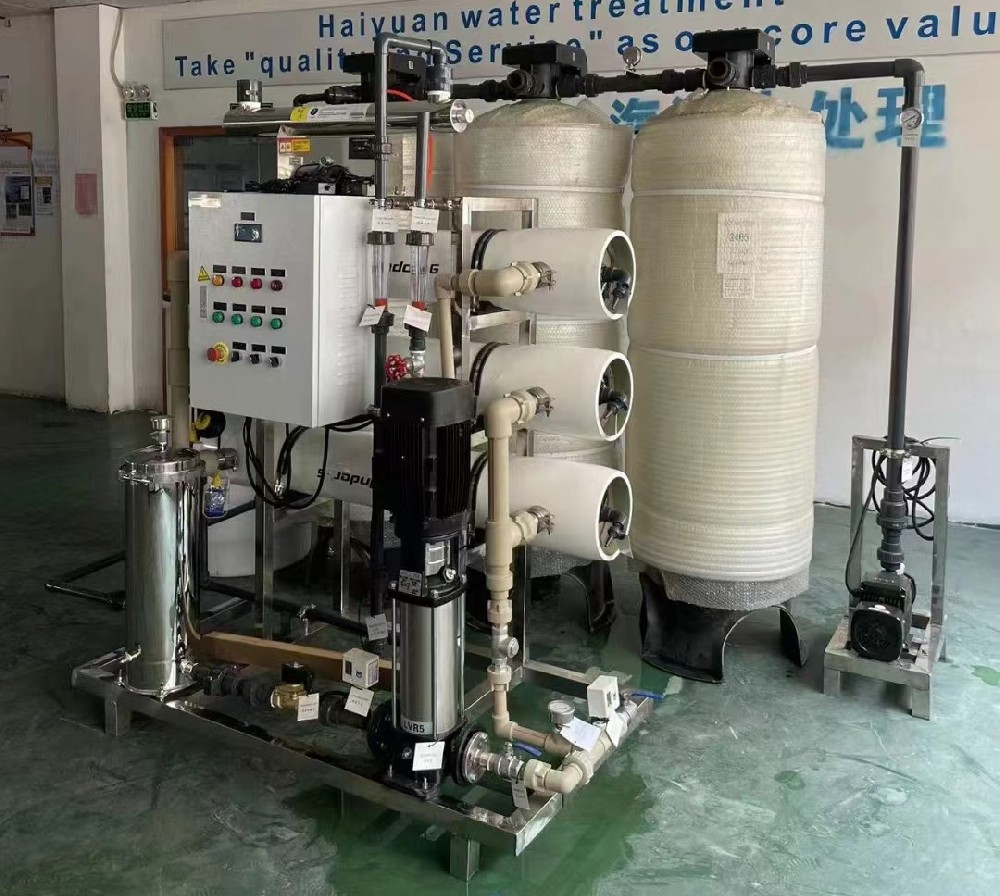
Wechat/Whatsapp:
+8613798883773

Wechat/Whatsapp:
+8613798883773
HYWATER Reverse Osmosis plant/system


Leak detection methods for RO water treatment equipment Soap method Soap method is a very common method. Apply a certain pressure to the test object and apply soapy liquid to the outside. If there is leakage, air bubbles will be generated. According to the soap liquid detection method, gas pressure is used to determine the leakage location and the leakage amount. Any gas can be used as long as the pressurization is not dangerous. The characteristic of this detection method is that when conducting a leak test, it is not necessary to stop the operation of the RO water treatment equipment or disconnect the tested object, and the operation can be performed at any time. Hydraulic method When testing a pressure vessel, fill the vessel or RO water treatment equipment with water, and then inject water into it with a hydraulic pump. Because this method pressurizes the water, the expansion of the water is small, and the pressure can be immediately increased; therefore, once the container is damaged, the bolt of the connecting part is broken, the gasket is flying off, etc., it will not cause danger. Sound method The detection principle of the sound method is that when the gas is ejected from the small hole, it will emit a sound. The size and frequency of the sound depend on the size and frequency of the leaking person, the pressure on both sides, the pressure difference and the type of gas. This method is very primitive. It depends on the sound of listening to determine whether there is leakage. Unlike other methods, it can clearly indicate the level of the detected sensitivity. The detection sensitivity of this method will be affected by the environment, but it is relatively simple and economical, and the ear and stethoscope are generally used. Ultrasonic method The ultrasonic method is to partially cut off the audible frequency in the leaking sound, only amplify the ultrasonic part, and detect it to find the leak. When testing, you can directly use the ultrasonic wave to make the pointer of the meter swing, or you can use the method of returning the ultrasonic wave to the audible frequency range to whistle. Under the noise conditions of ordinary factories, the ultrasonic converter is not disturbed, so only the ultrasonic part is detected, and the effect is very good. When judging the leak point, adjust the sensitivity of the leak detector to the maximum, and move the microphone while listening to the questionable place; Maximize the sound of the ultrasonic sound, and then look for the place where the ultrasonic sound is emitted. In comparison, this method has less personal error. Rubber membrane method The rubber film method refers to sticking a rubber film and a plastic film tape at the leaking place, connecting a funnel on it, and sticking a thin rubber or film on the funnel. If there is a leak, the balloon will bulge. This method is used in the gas pipelines used in large factories. Observed with the naked eye, no matter who observes, the results are the same. Gas detection method The gas detection method refers to the use of a gas other than air to pressurize the test vessel, and a barrel that will react with the gas is placed outside the container. If there is a leak of RO water treatment equipment, the gas goes outside and reacts with the substance in the barrel, and then the reaction substance is detected by the detector. Such as the use of test strips to measure the leakage of ammonia, this method is used. The detection method is very simple and widely used in factories, but attention should be paid to the accuracy of the instrument. Radioisotope method The radioisotope method uses radioactive gases that are not harmful to the human body for leak detection. Pressurize the test container with air containing a small amount of radioactive gas. If there is leakage, the radioactive gas will leak out; y-rays can be detected by a scintillation counter, etc., so as to know whether there is leakage and the approximate amount of leakage. This assay is expensive and requires a high level of expertise for the user. Semiconductor testing method When a semiconductor adsorbs a certain gas, the electrical conductivity changes. Based on this principle, a new technology that uses semiconductors for gas detection has occurred. The detection method is accurate, the error is small, and it is more economical, but the stability is not very good. Halogen pressurization method Pressurize the container with halogen gas. If there is leakage of halogen gas, the halogen detector will fluctuate immediately, and it can be judged whether there is leakage. The condensers of large factories and power plants all use halogen detectors for leak detection, which is more convenient and practical. Vacuum method The vacuum method refers to evacuating the inspection vessel, and then coating the detection site with liquids such as water, alcohol, acetone, etc.; if the solution touches the leak hole and covers the hole, flow will occur and a leak will be found. Thermal conductivity detection method The thermal conductivity of various gases is determined by Xiaotong. If you know the thermal conductivity, you can know what gas is mixed in the known gas. The thermal conductivity detector is more accurate, reliable and stable. More inquiries related to RO water treatment equipment please contact: Mob& Wechat& WhatsApp: (+86)13544774483 Email: sales010@water-sy.com We will provide high-quality, all-round comprehensive professional services for project consulting, system design, manufacturing, installation and commissioning, personnel training, etc
